Disclosure: We may earn commissions if you purchase products after clicking on a link from our site.
When it comes to hunting muskrats, you might think it’s about patience and observation. However, there’s more to it than meets the eye. Understanding their behavior and habitats is just the beginning. Before you start on your muskrat hunting journey, there are essential aspects you need to know about how to hunt muskrats.
From identifying their physical characteristics to selecting the right gear, each step plays a significant role in your success. But what about legal considerations and ethical hunting practices? Well, let’s uncover the intricacies of hunting these elusive creatures and how you can master the art of muskrat hunting.

Table of Contents
- 1 Key Takeaways
- 2 Understanding Muskrat Behavior
- 3 Identification & Physical Characteristics
- 4 Natural Food Sources
- 5 Muskrat Hunting Gear
- 6 Legal Considerations
- 7 Legal Hunting Methods
- 8 Hunting Techniques
- 9 Muskrat Burrows and Dens
- 10 Muskrat’s Role in the Ecosystem
- 11 Under Ice Trapping
- 12 How to Hunt Muskrat for Beginners
- 13 How to Trap Muskrats in Ponds
- 14 How to Prevent Muskrats
- 15 Muskrat Hunting Season
- 16 Bait and Lure
- 17 Safety Measures
- 18 Hunting Ethics and Best Practices
- 19 The Bottom Line
Key Takeaways
- Understand muskrat behavior and habitats for effective hunting.
- Use appropriate hunting techniques and gear like traps or spot-and-stalk.
- Ensure trap preparation, safety, and humane disposal practices.
- Utilize trap placement strategies near active dens and feeding areas.
- Consider the muskrat’s role in the ecosystem and adhere to hunting regulations.
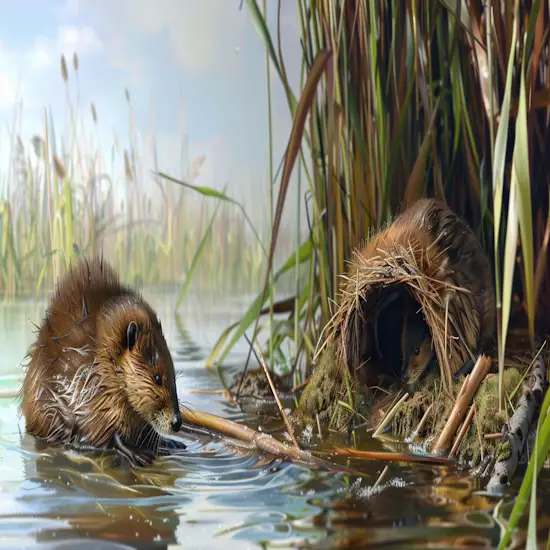
Understanding Muskrat Behavior
To effectively hunt muskrats, it’s essential to understand their behavior and habitats. Muskrats are skilled swimmers that reside in wetlands like marshes, ponds, and lakes.
Muskrat Habits
Muskrats exhibit distinctive behaviors that reflect their adaptation to their wetland habitats.
- Nocturnal Activity: Muskrats are primarily active during the night, foraging and building their lodges under the cover of darkness.
- Social Creatures: They’re known to live in colonies, sharing dens and engaging in social interactions with other muskrats.
- Territorial Defense: Muskrats are territorial animals and will defend their territory by marking it with scent glands and engaging in aggressive behaviors towards intruders.
- Seasonal Behaviors: Their behaviors vary with the seasons, with increased activity during the warmer months for feeding and breeding, while they tend to be more dormant in the winter, relying on food caches in their lodges.
Understanding these habits can be vital when planning your hunting strategies for muskrats.
Muskrat Habitats
Understanding muskrat habitats involves observing their behavior in wetland ecosystems to effectively plan your hunting strategies. Muskrats prefer wetlands like marshes, ponds, and lakes, where they can swim using their partially webbed hind feet. These creatures primarily feed on vegetation and animals such as crayfish. They build burrows along water banks for protection and contribute to wetland ecosystems by stimulating plant regrowth.
When hunting muskrats, keep an eye out for moving water with soft banks, ideal for muskrats to dig dens. Avoid drained irrigation ditches and shallow marshlands, and seek permission before entering private bottomlands. Look for rivers and tributaries that attract muskrats from frozen ponds.
Identifying muskrat dwellings like cattail huts in lakes and marshes can guide your hunting efforts. Be cautious around huts and thin ice near active dens. Recognize bank dens by packed runs, bubbles beneath ice, and root cuttings around the area. By understanding muskrat habitats, you can increase your hunting success.
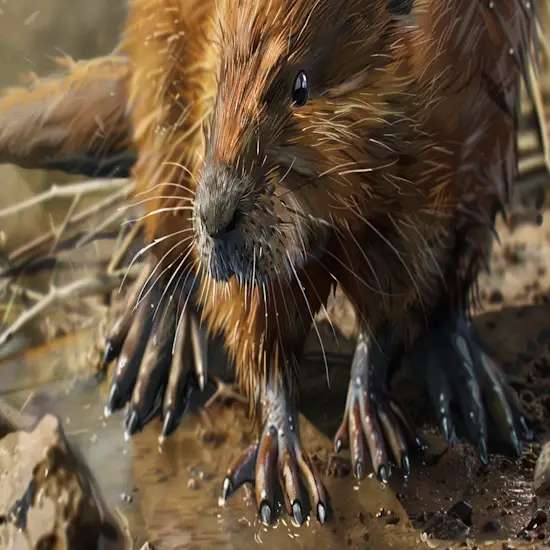
Identification & Physical Characteristics
Identifying muskrats is straightforward due to their distinct physical features, such as their partially webbed hind feet and ability to swim with proficiency in wetland habitats.
- Muskrats have a stocky body with a rounded tail.
- They typically measure around 16-24 inches in length.
- Their fur is dense, waterproof, and varies in color from brown to black.
- Muskrats have small eyes and ears located close to the head for streamlined swimming.
These physical characteristics enable muskrats to thrive in aquatic environments, making them well-adapted for life in wetlands.
When spotting these animals, their unique traits and behaviors make them easily distinguishable from other wildlife. Their appearance and features are tailored to their semi-aquatic lifestyle, allowing them to navigate through water with ease and efficiency.
Understanding these distinctive physical attributes will aid you in correctly identifying muskrats during your hunting excursions.
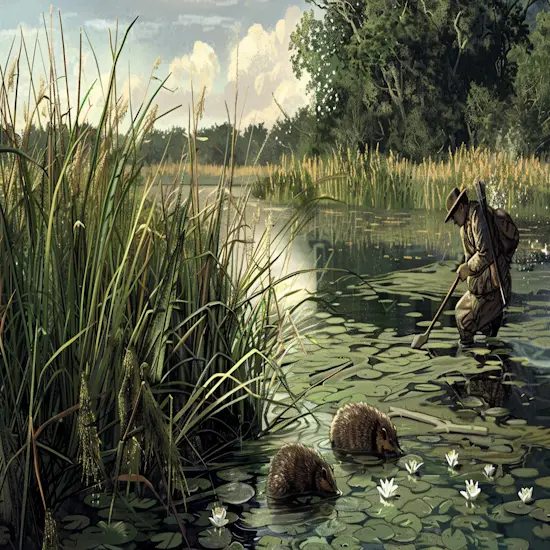
Natural Food Sources
To effectively hunt muskrats, it’s essential to understand their natural food sources. Muskrats primarily feed on vegetation such as cattails, water lilies, and bulrushes. They also consume aquatic plants like pondweeds and duckweeds. In addition to plants, muskrats supplement their diet with small animals like snails, mussels, and crayfish. Understanding these food preferences can help you choose the right bait to attract muskrats to your traps effectively.
Observing muskrat feeding areas can give you valuable insights into their natural food choices. Look for signs like partially eaten plants, shells from mollusks, and small crustacean remains near water banks. By placing your traps strategically in these areas, you increase your chances of a successful catch. Remember to use bait that mimics their preferred food sources to lure muskrats into your traps. With this knowledge, you’re better equipped to hunt muskrats successfully.

Muskrat Hunting Gear
Choose the right gear to enhance your muskrat hunting experience. To make the most of your hunting trip, consider these essential items:
- Waders and Protective Clothing: Keep dry and comfortable while traversing wetlands with waterproof waders and clothing to shield yourself from the elements.
- Trap Types: Select traps that suit your hunting needs, such as Conibear traps for efficient trapping under ice or bank traps for capturing muskrats near their dens.
- Bait: Use bait that mimics muskrats’ natural food sources to attract them to your traps effectively.
- Clean and Strategically Placed Traps: Make sure your traps are clean, deodorized, and positioned strategically near muskrat activity areas for best results.

Legal Considerations
When preparing to hunt muskrats, remember to obtain the necessary licenses and permits before setting traps. It’s important to follow local regulations to guarantee ethical and legal trapping practices. Failure to comply with licensing requirements can result in fines or legal consequences.
Licensing and Permits
Understanding the licensing and permit requirements is crucial before engaging in muskrat hunting activities.
- Check Your State Regulations: Verify the specific licenses and permits needed for trapping muskrats in your state.
- Obtain the Necessary Permits: Acquire the appropriate licenses and permits from the relevant wildlife agency before setting traps.
- Renewal and Reporting: Understand any renewal deadlines for licenses and permits, and adhere to reporting requirements.
- Compliance with Regulations: Guarantee full compliance with all regulations regarding muskrat hunting to avoid legal repercussions.

Legal Hunting Methods
For legal hunting of muskrats, make sure you comply with trapping regulations to use approved methods. Trapping muskrats can typically be done using traps like Conibear traps, foothold traps, and colony traps. These traps are designed to capture muskrats humanely and effectively.
It’s important to check your state’s regulations to make sure you’re using the appropriate trap types and sizes. Always place traps in areas where muskrats are active, like near their burrows or along their regular pathways. Remember to check your traps regularly to minimize suffering and comply with ethical hunting practices.

Hunting Techniques
When hunting muskrats, you’ll employ various techniques like trapping, spot and stalk, and even the use of dogs. Each method offers its advantages and requires specific skills to execute successfully. Let’s explore these techniques to enhance your muskrat hunting experience.
Trapping
To start discussing trapping techniques for muskrat hunting, understand the regulations that govern trapping in your region.
Select the appropriate trap types based on their advantages and intended use.
Guarantee safety by preparing traps correctly and implementing strategic placement strategies to increase your trapping success.
Understanding Trapping Regulations
Understanding trapping regulations is crucial for successful and ethical muskrat hunting. To guarantee compliance and responsible trapping, consider these points:
- Obtain necessary permits and licenses.
- Follow set trapping seasons and restrictions.
- Adhere to trap size and placement regulations.
- Respect property rights and boundaries.
Types of Traps and Their Uses
Knowing the types of traps available and their specific uses is key to successful muskrat hunting. Conibear traps are ideal for trapping under ice, while foothold traps work well near bank dens.
Colony traps can catch multiple muskrats at once. Body-gripping traps are effective but must be used with caution. Understanding each trap’s purpose and placement will improve your hunting efficiency and yield better results.
Trap Preparation and Safety
Prepare your traps meticulously and prioritize safety measures to guarantee effective muskrat hunting.
- Always wear protective gear like gloves and eye protection.
- Regularly check traps to minimize suffering and comply with regulations.
- Keep traps away from areas accessible to pets or children.
- Dispose of captured muskrats humanely and responsibly.
Trap Placement Strategies
When setting traps for muskrats, consider placing them strategically near active bank dens for best trapping success. Muskrats frequently use these dens and are likely to encounter your traps there. Look for signs like packed runs and bubbles beneath the ice to identify these areas.
Spot and Stalk
To effectively employ the spot and stalk hunting technique, observe the muskrats’ movements and habits in their natural wetland habitat.
- Stay Downwind: Guarantee you approach muskrats from a direction where the wind carries your scent away from them.
- Move Slowly and Quietly: Take slow, deliberate steps to avoid startling the muskrats with sudden movements or noise.
- Use Natural Cover: Blend in with your surroundings by utilizing vegetation and terrain to conceal your approach.
- Patience is Key: Wait for the right moment to make your move and take your shot when the muskrats are within range.
Use of Dogs
Using dogs in muskrat hunting can enhance your trapping efficiency and success in capturing these elusive creatures. Dogs, particularly breeds like terriers or spaniels, are valuable assets in locating muskrat dens along water banks. These canines have a keen sense of smell and are adept at tracking muskrats to their burrows.
When trained for muskrat hunting, dogs can help you identify active dens by detecting muskrat scents and movements. Once a den is located, dogs can also assist in flushing out muskrats, making it easier for you to set traps or capture them more swiftly.
Additionally, dogs can provide security and companionship during your hunting expeditions, adding an extra layer of enjoyment to the experience. Training your dog to assist in muskrat hunting requires patience, consistency, and positive reinforcement. With proper training and guidance, your furry companion can become an invaluable partner in your quest to hunt muskrats efficiently.

Muskrat Burrows and Dens
When hunting muskrats, locating their bank den and burrow sets is essential. These dens provide shelter and protection for the muskrats.
Look for signs like packed runs, bubbles beneath the ice, and root cuttings to identify these key locations accurately.
Bank Den and Burrow Sets
For effective trapping of muskrats, look for signs of their bank dens and burrows in wetland habitats like marshes, ponds, and lakes.
- Identifying Bank Dens: Search for packed runs and bubbles beneath the ice as indicators of muskrat bank dens.
- Observing Surroundings: Notice root cuttings around bank dens and look for fresh white or green roots floating in the water nearby.
- Exercise Caution: Be wary of huts on thin ice near active dens, especially during winter trapping.
- Signs of Activity: Recognize muskrat presence by the cattail huts in lakes and marshes, which serve as their dwelling structures.

Muskrat’s Role in the Ecosystem
Muskrats play an essential role in the ecosystem by stimulating plant regrowth and contributing to wetland health. As they feed on vegetation, muskrats help control plant overgrowth, promoting the growth of new plants. Their burrowing activities create channels that improve water flow, which benefits other wetland species. By creating pathways and openings in marshes and ponds, muskrats help maintain diverse habitats for various wildlife.
In addition, muskrats serve as an important food source for predators like foxes, minks, and birds of prey, contributing to the intricate balance of the food chain in wetland ecosystems. Their activities also impact nutrient cycling, as their feeding habits and burrowing behavior influence soil composition and nutrient distribution.
Preserving muskrat populations is essential for the overall health and biodiversity of wetlands. Understanding and appreciating the role of muskrats in the ecosystem is key to promoting conservation efforts and maintaining the delicate balance of nature.

Under Ice Trapping
To effectively trap muskrats under ice, make sure your Conibear traps are strategically placed near active bank dens.
- Strategic Placement: Position Conibear traps close to active bank dens to increase trapping success.
- Understand Muskrat Behavior: Learn to identify signs of muskrat activity under ice to target trapping efforts effectively.
- Check Ice Thickness: Always confirm the ice is thick enough to support your weight before venturing onto frozen water bodies.
- Safety First: Prioritize safety by using appropriate gear like ice picks and wearing a life jacket when trapping under ice.
Trapping muskrats under ice can be a rewarding experience, but safety should always be your top concern. By following these tips and understanding muskrat behavior, you can increase your chances of a successful trapping season.

How to Hunt Muskrat for Beginners
When starting out hunting muskrats as a beginner, focus on understanding their habitats and behaviors. Muskrats are commonly found in wetlands like marshes, ponds, and lakes. They are skilled swimmers with partially webbed hind feet, feeding on vegetation and animals like crayfish. Building burrows along water banks for protection, muskrats play an important role in wetland ecosystems by stimulating plant regrowth. To help you visualize their habitats better, here is a breakdown in the table below:
| Muskrat Habitat Features | Description | Location |
|---|---|---|
| Moving Water | Soft banks for den digging | Rivers, tributaries |
| Huts and Bank Dens | Cattail huts and packed runs | Lakes, marshes |
| Miles Check | Trap check regulations awareness | Radius from home |

How to Trap Muskrats in Ponds
In hunting muskrats in ponds, patience and precision are key to successful trapping.
- Choose the Right Location: Identify areas in the pond where muskrats are active, such as near bank dens or feeding spots.
- Select the Appropriate Trap: Opt for traps like foothold or colony traps that suit pond environments.
- Set Traps Strategically: Make sure traps are placed securely in water entrances to burrows or along muskrat pathways.
- Regularly Check Traps: Visit traps frequently to minimize suffering and comply with ethical trapping practices.
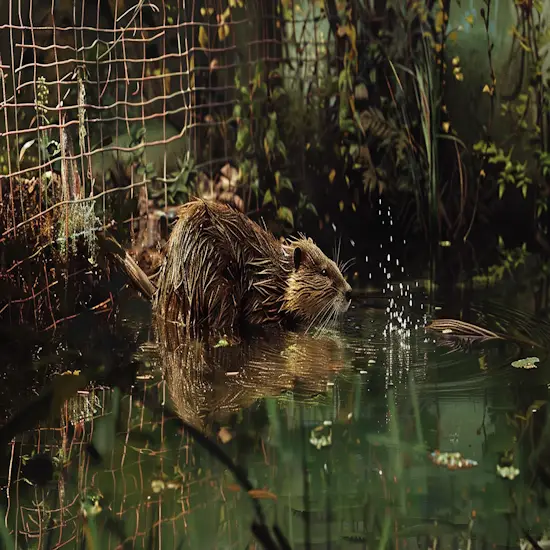
How to Prevent Muskrats
Prevent muskrats by implementing effective habitat modifications. To deter these critters, clear away excess vegetation and debris near water sources. Muskrats are drawn to areas with abundant aquatic plants and vegetation, so reducing these can make your property less appealing to them.
Consider installing wire mesh barriers around the base of trees and shrubs to prevent muskrats from gnawing on them. Additionally, filling in burrows and sealing off entry points along water banks can discourage them from settling in.
Regularly inspect and maintain these modifications to guarantee their effectiveness in keeping muskrats at bay. By taking these steps, you can proactively prevent muskrats from becoming a nuisance on your property without resorting to more drastic measures.
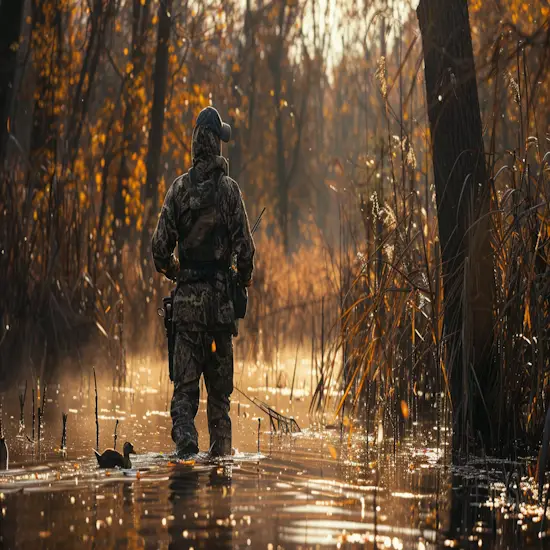
Muskrat Hunting Season
To hunt muskrats successfully during their season, familiarize yourself with the regulations and gear needed.
- Check Regulations: Make sure you’re aware of the specific hunting season for muskrats in your area.
- Get the Right Gear: Equip yourself with items like waders, traps, and bait for effective hunting.
- Understand Hunting Zones: Know where muskrats are most active to increase your chances of a successful hunt.
- Practice Ethical Trapping: Follow trapping laws and guidelines to guarantee sustainable hunting practices.
Understanding the hunting season and being prepared with the right equipment will greatly improve your chances of a successful muskrat hunt. By adhering to regulations, using appropriate gear, targeting active zones, and trapping ethically, you can make the most of the hunting season and enjoy a rewarding experience in the wetlands.
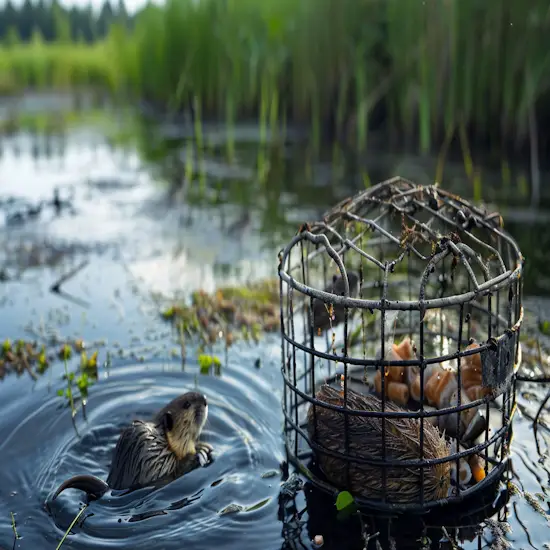
Bait and Lure
If you want to attract muskrats effectively, consider using bait and lures that mimic their natural food sources. Muskrats are drawn to scents and flavors that resemble what they typically consume in their habitat. Opt for baits like fresh vegetables, fruits, and aquatic plants. Carrots, apples, or water lilies can be enticing options. Additionally, muskrats are known to be attracted to anise oil or vanilla extract scents. These scents can be added to your bait or used as a lure to pique their interest.
When choosing lures, aim for those that replicate the sounds and movements of muskrats’ prey. This could include imitations of crayfish or other small aquatic creatures. Lures that create ripples or splashes in the water can also grab the attention of muskrats. By utilizing baits and lures that resonate with muskrats’ natural instincts, you increase your chances of a successful hunt.
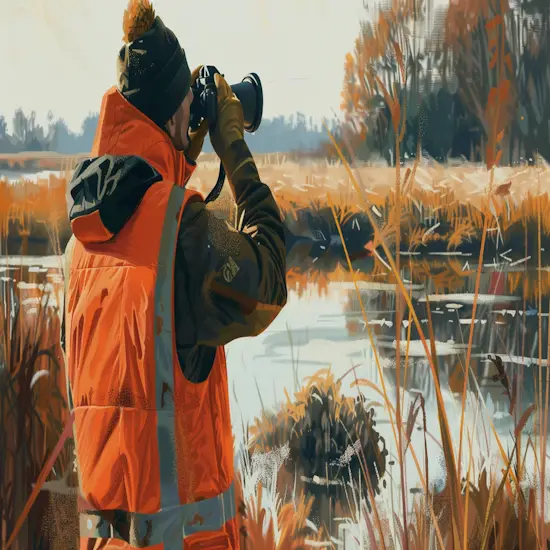
Safety Measures
When hunting muskrats, remember to prioritize personal safety and environmental safety. Wear appropriate protective gear like waders and gloves to prevent accidents. Always be mindful of your surroundings to avoid harming yourself or the ecosystem.
Personal Safety
For ensuring your safety while hunting muskrats, prioritize understanding and implementing essential safety measures.
- Wear Appropriate Gear: Equip yourself with waders, protective clothing, and gear suitable for the hunting environment.
- Inform Others: Always let someone know your hunting plans, including your expected return time and location.
- Stay Alert: Be aware of your surroundings, especially when near water bodies, to prevent accidents.
- Handle Firearms Safely: If using firearms, follow proper gun safety protocols at all times.
Environmental Safety
To guarantee environmental safety while hunting muskrats, prioritize understanding and implementing essential conservation practices.
Always respect the natural habitat of muskrats by avoiding unnecessary disturbances to wetlands and their surroundings.
Make sure to dispose of any waste properly, including bait containers and other hunting materials, to prevent pollution and harm to the ecosystem.
When setting traps, place them strategically to minimize unintended catches of non-target species and follow local regulations to preserve wildlife populations.
Additionally, be mindful of using non-toxic bait and materials to prevent contamination of water sources and safeguard the well-being of other wildlife in the area.
By being environmentally conscious and practicing responsible hunting techniques, you contribute to the overall health and sustainability of muskrat habitats for future generations of both wildlife and hunters.
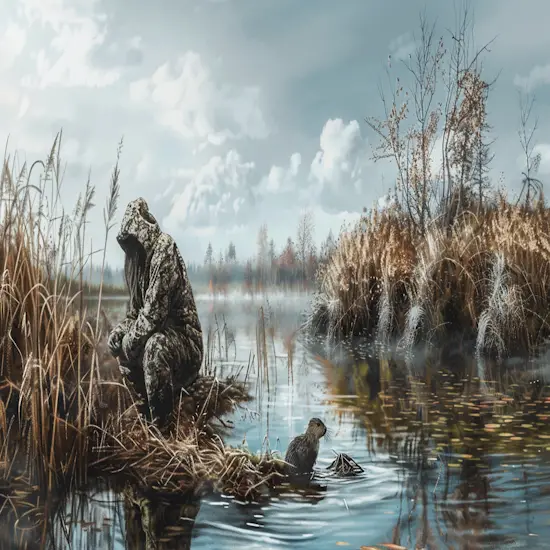
Hunting Ethics and Best Practices
Understanding hunting ethics and best practices is crucial for responsible and successful hunting expeditions.
- Respect Wildlife:
Always prioritize the humane treatment of animals and follow regulations to guarantee sustainable hunting practices.
2. Safety First:
Maintain awareness of your surroundings, use appropriate gear, and follow firearm safety protocols to prevent accidents.
3. Hunt Responsibly:
Practice fair chase principles, avoid overhunting in an area, and contribute to conservation efforts for future generations.
4. Education and Improvement:
Continuously educate yourself on hunting laws and techniques, seek mentorship, and aim to enhance your skills for more ethical hunting experiences.
The Bottom Line
Hunting muskrats requires a blend of knowledge, skill, and respect for the animal and its environment. By understanding muskrat behavior, using the right gear, adhering to legal requirements, and employing effective hunting techniques, you can enhance your hunting experience while contributing to sustainable wildlife management. If you would like to hunt otters and beavers, you can read how to hunt otters and how to hunt beavers.